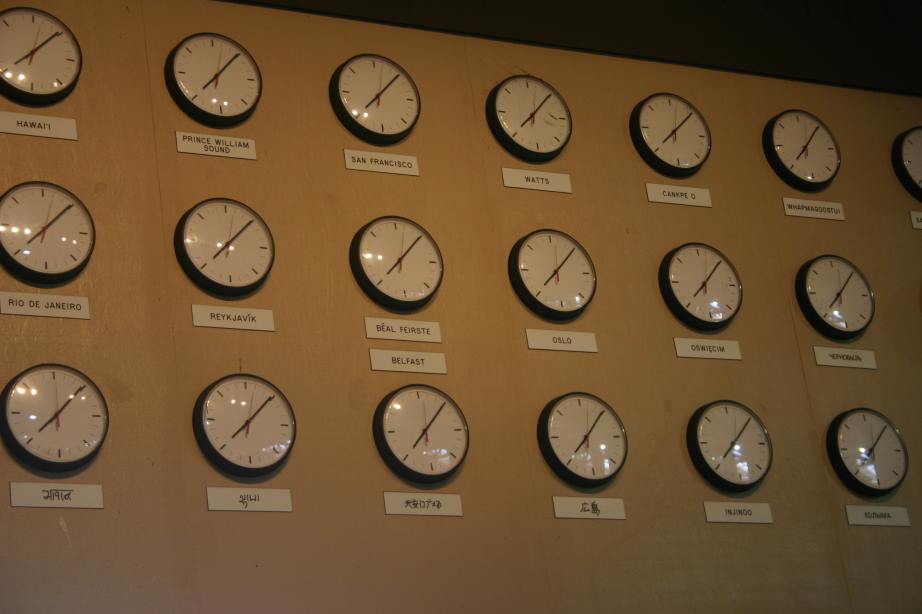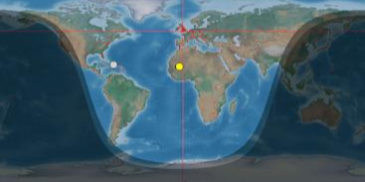One World Time
by Ed Sawicki - August 21, 2017 - updated in 2020

In the late 1990s, I was running through an airport somewhere in the world and spotted the above wall of clocks that were all indicating the same time. The system controlling the clocks wasn't working. I quickly snapped a photo, rushed to my gate, and boarded the plane. After I settled into my seat, I reflected on the idea of a world without time zones. I took out my computer and began typing notes that, two decades later, became this article.
The basic idea is that all the clocks in the world display the same time. In our Internet-connected world, where information is instantly moved between points on Earth, this makes a lot of sense. We adapt our local needs to that universal time when necessary. For example, people in London have 9-to-5 jobs but on the East Coast of the United States jobs are 5-to-1. Those on the West Coast have 2-to-10 jobs. It would take a little time to get accustomed to but nothing like, say, learning to play the piano and not more complicated than setting an alarm clock. It would be second nature to those who are born into it.
I tested the idea of a single world time zone on people I knew. Nobody thought that it was a good idea. The typical question asked by them was, “Does this mean that I have to go to work in the dark?” and “What about the farmers?” All their objections related to sunlight—sunrise (and to a lesser degree, sunset) had to occur at times when the numbers on their clock face were the same as they have always been. If a “single time zone world” caused their morning to start at, say, 2:00, that would be wrong—just wrong.
I covered this in one of the college computer classes I taught. Computers need to deal with time zone issues. Only one student thought it was a good idea. Many students came up with creative objections. For example, one asked, “Which of the existing time zones would become the standard time zone?” I said that the most obvious choice is the time zone that passed through Greenwich, England. That time zone is called Greenwich Mean Time (GMT). It's the zero-offset time zone. All others are plus or minus hours from it. Additionally, GMT had been the standard time zone for almost two centuries.
At the time, I taught at a college that attracted students from rural areas. Most had never traveled abroad and had conservative ideas. They didn't like America having to follow some other country's time zone. One student said, “We beat them in World War Two. We should get to be the standard time.” A few other students nodded their heads in agreement. That some of my students thought the U.S. had fought Britain in World War II was quite distressing. I didn't consider their opinions on time zones to be useful.
Technology and time zones
Computers, the Internet, smartphones, and other modern technology are capable of handling most issues that arise from the elimination of time zones. Let's look at using your smartphone to place phone calls. Suppose you want to phone the Acme Rocket Parts company in Zurich. What could your smartphone do if you tried to place the call at a time of day when Acme was not open for business?
- The call is placed and Acme's phone system handles time-of-day issues, such as taking you to voice mail.
- Your phone tells you, “They are not yet open for business. Their business day begins in two hours. Do you still want to place the call?”
- Your phone tells you, “Acme requests that you use their contact form. Shall I take you there?”
Calling a friend or family in another city is a little different. You wouldn't want to disturb them when they're sleeping. What could happen when you tell your phone, “Call Jill Clark”
- The call is placed and Jill's phone handles time-of-day issues. She can configure her phone to not ring after a certain hour.
- Your phone, knowing where Jill is located, could tell you, “It's mid-evening for Jill. Do you still want to call Jill?”
- or, “Jill's phone is set to do-not-disturb. It's evening there. Do you still want to call Jill and use the emergency code?”
Texting can be handled the same way. There is no detrimental impact on email.
If you need to know the places that are currently in daylight, your phone or computer could show you a daylight map:

If you need to know when daylight occurs at other times, a simple display could show you (24-hour time is shown here):

But think about how often you're interested in knowing where sunlight is in the world. You hardly ever think about it.
Mental exercises
If you're having trouble grasping the concept of one-time for the planet, here are a few exercises that may help.
- If you could go back in time and change how the world keeps time, what would you do? To make it more interesting, assume that your memory of present-day timekeeping was erased when you were transported back but you still retained your knowledge of our Base Ten numbering system. Would it occur to you to have 24-hour days broken into two 12-hours periods (am/pm)? 60-minute hours? 60-second minutes? Base Ten subseconds?
- When we have colonies on the Moon with roads that traverse its entire circumference, should there be time zones there?
- What about colonies on Mars?